
Acacia aneura, commonly known as mulga or true mulga, is a shrub or small tree native to arid outback areas of Australia. It is the dominant tree in the habitat that it gives its name to (mulga) that occurs across much of inland Australia. Specific regions have been designated the Western Australian mulga shrublands in Western Australia and Mulga Lands in Queensland.
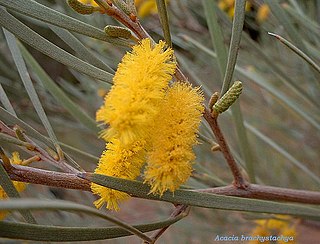
Acacia brachystachya, commonly known as umbrella mulga, turpentine mulga or false bowgada, is a shrub in the family Fabaceae. The species occurs in mulga and heath communities on sandhills and rocky ridges in all mainland states of Australia, except Victoria.

Acacia coriacea, commonly known as river jam, wirewood, desert oak, wiry wattle or dogwood, is a tree in the family Mimosoideae of family Fabaceae. Indigenous Australians know the plant as Gunandru.
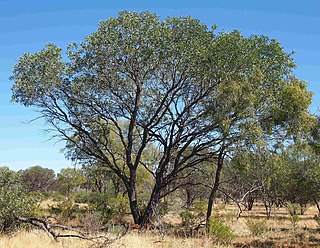
Acacia pruinocarpa, commonly known as black gidgee, gidgee or tawu, is a tree in the family Fabaceae that is endemic to arid parts of Australia.

The hairpin banksia is a species of woody shrub, of the genus Banksia in the family Proteaceae, native to eastern Australia. Widely distributed, it is found as an understorey plant in open dry forest or heathland from Victoria to northern Queensland, generally on sandstone though sometimes also clay soils. It generally grows as a small shrub to 2 metres (7 ft) in height, though can be a straggly tree to 6 metres (20 ft). It has long narrow leaves with inflorescences which can vary considerably in coloration; while the spikes are gold or less commonly yellowish, the emergent styles may be a wide range of colours – from black, purple, red, orange or yellow.

Banksia sphaerocarpa, commonly known as the fox banksia or round-fruit banksia, is a species of shrub or tree in the plant genus Banksia. It is generally encountered as a 1–2 m (3.3–6.6 ft) high shrub, and is usually smaller in the north of its range. This species has narrow green leaves, and brownish, orange or yellow round flower spikes which may be seen from January to July. It is widely distributed across the southwest of Western Australia, growing exclusively in sandy soils. It is usually the dominant plant in scrubland or low woodland. It is pollinated by, and is a food source for, birds, mammals, and insects.
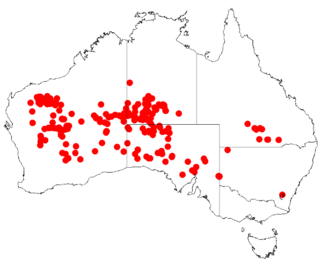
Acacia ayersiana is a plant that grows in arid areas of Australia.
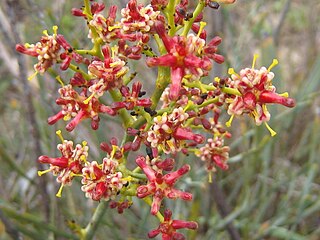
Stirlingia latifolia, commonly known as blueboy, is a plant endemic to Western Australia.
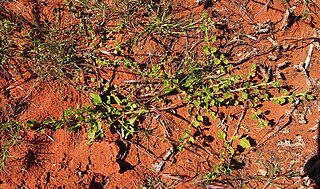
Dysphania melanocarpa, commonly known as Black Crumbweed, is an annual herb that grows in arid and semi-arid regions of Australia.

Enchylaena tomentosa, commonly known as barrier saltbush or ruby saltbush, is a small native shrub of Australia.

Amyema quandang is a species of hemi-parasitic shrub which is widespread throughout the mainland of Australia, especially arid inland regions, sometimes referred to as the grey mistletoe.

Ehretia saligna, commonly known as peach bush, native willow and peachwood is a species of shrubs or small trees, endemic to Northern Australia. The natural range extends from the Gascoyne, across the Northern Territory throughout northern Queensland and coastal; regions of Southern Queensland and New South Wales.

Melaleuca pentagona is a plant in the myrtle family Myrtaceae and is endemic to the south of Western Australia. It is a showy, medium-sized shrub which produces large numbers of pink flowers in spring. There are three varieties recognised, one of which has been known in cultivation for many years.

Acacia aptaneura, commonly known as slender mulga, is a shrub belonging to the genus Acacia and the subgenus Juliflorae. It is native to central and western parts of Australia.

Acacia fuscaneura, commonly known as sooty wattle, is a tree belonging to the genus Acacia and the subgenus Juliflorae. It is native to arid areas of central Australia.

Acacia minyura is a tree or shrub belonging to the genus Acacia and the subgenus Juliflorae endemic to arid parts of central Australia.

Acacia ramulosa, commonly known as horse mulga or bowgada wattle, is a shrub belonging to the genus Acacia and the subgenus Juliflorae endemic to arid areas of Australia.

Acacia oswaldii, commonly known as boree, umbrella wattle, umbrella bush, whyacka, middia, miljee, nella and curly yarran, is a shrub or tree of the genus Acacia and the subgenus Plurinerves.
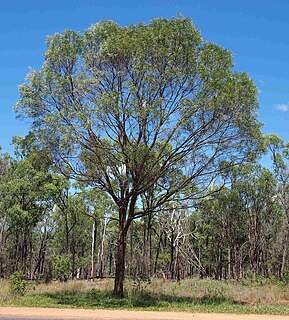
Acacia shirleyi, known colloquially as lancewood, is a species of Acacia native to Queensland and the Northern Territory in Australia. It grows as a tree to 15 metres (49 ft) high, with dark grey or black stringy bark and blue-grey foliage. The yellow flowers appear from March to July. It grows in dry scrub, open forest or mixed savannah woodland. Indigenous people used the wood as fuel and to make hunting spears. Cattle can eat the foliage as fodder.


















